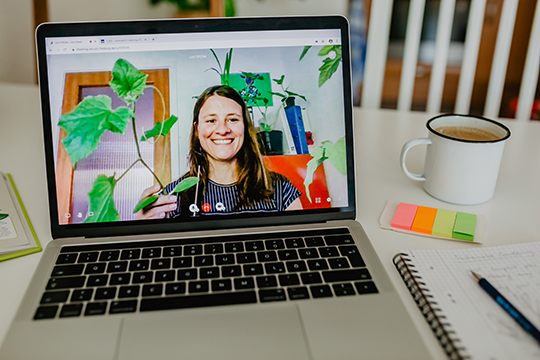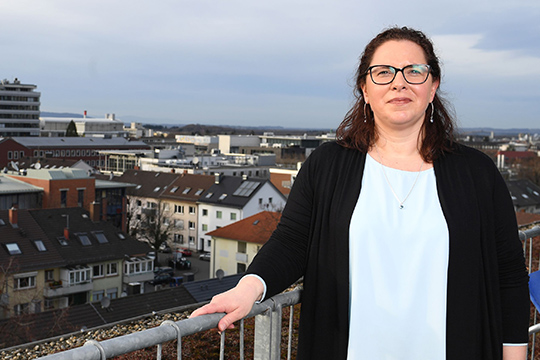Ready to Grow
Freiburg, May 08, 2020
Digital teaching and learning has skyrocketed in recent weeks. Compared to the start of the semester last year, the number of available videos on the E-learning platform ILIAS has quadrupled. But what’s the best approach for teachers and students to take in these new conditions. The University of Freiburg has created a wide-ranging portfolio of solutions tailor-made to meet the needs of the current situation. There are online office hours, webinars, and instructions for online conferencing. Judith Burggrabe spoke with the Head of the E-Learning Service Center, Dr. Nicole Wöhrle, and the Head of the Department of Teaching and Learning, Silke Weiß, about the challenges ahead in daily life for the university community.

In only a few weeks, teachers at the University of Freiburg have converted their seminars and lectures into digital format, for example a seminar on sustainable gardening that uses video conferences. Photo: Sandra Meyndt
Ms. Weiß, what do you recommend students do in the coming months?
Silke Weiß: It’s important that they structure their own learning and get used to digital, asynchronous, learning formats. Students should get a good overview of which courses they are taking this semester, what the requirements of the courses are, and incorporate their study tasks appropriately into a schedule. Part of that is developing awareness of what was already set out by teachers and requirements to attend class up to now. For example, if you had a course that required you to be in lecture hall XY from eight a.m. to ten a.m. on Wednesdays – that obligation may be gone now, but you should nevertheless plan to dedicate the two hours to studying for that course.
And what’s your advice for teachers?
Silke Weiß: They need to transition to a digital semester by carefully considering what course content and activities can sensibly be transferred to digital teaching and learning scenarios. Creativity is in demand there, too. Some things can’t be duplicated one-to-one. The point isn’t to recreate a group discussion that involves thirty people. Instead, they need to analyze the instructional objective of the debate and how it can be reached by other means. A small group discussion can be just as expedient and it's technologically possible as a rule.
The Department of E-Learning has made a wide-ranging, fundamental, technical offering available for just these purposes. Ms. Wöhrle, what is there, actually?
Nicole Wöhrle: In recent weeks, we’ve given thirteen webinars on specific topics. They range from “How do I log in to the ILIAS learning platform and create a course?” to “How do I add audio narration to a video and record lectures?” all the way to tips such as “Online Moderating for Live Seminars.” We also have created templates so teachers can quickly and simply get on with working with the learning platform and establish the basics.

Silke Weiß advises instructors to have the "courage to accept their own flaws" as they try digital teaching formats, even if things don't run smoothly the first time around. Photo: Patrick Seeger
Are more webinars planned?
Nicole Wöhrle: Yes, we’re working on them and determining what’s suitable and of interest. Beyond additional offerings for teachers, on 29 April 2020, we held a Webinar for Students. We are in touch with Central Academic Advising for that.
What type of technical equipment is required to use the digital offerings the university is providing?
Nicole Wöhrle: I can only tell you about uses involving the central university systems that we recommend in our E-Learning Training Program and in the newly created guidelines and webinars. Here the emphasis is on accessing the ILIAS learning platform and occasional participation in live conferences and seminars via video conferencing. The requirements for these are a stable, fast internet connection, with at least DSL speeds, and a terminal with which the students can learn well. To take part in a live conference, a laptop, tablet, or smartphone are best. As a rule, a camera and microphone are already incorporated in those devices. A simple laptop or home PC is sufficient for calling up and working with instructional materials and video recordings.
How did the Department of Teaching and Learning adjust their program to the current situation?
Silke Weiß: Our first step was setting up online office hours for teachers, so we could discuss opportunities and challenges in the context of individual instructional concepts. As we do this, we work with actual case studies. The second step was to make an effort to transition our own program to webinars or online courses. As we did that, we noticed than not every topic is suitable for purely digital realization. What is more, we’re working right now on creating a course for students on self-directed learning in virtual studies in order to support them during the summer semester.

“A centuries-old, traditional university can't morph into an online university in a few weeks without a hitch," says Nicole Wöhrle. Photo: Harald Neumann
Is the fact that technical systems are being used so heavily causing headaches?
Nicole Wöhrle: Now that everything is taking place digitally, we actually do have a completely different load being placed on our systems’ capacities. Even at the start of a normal semester, during the first two weeks there are always repeated usage peaks. That’s why we’re working hard to improve the technology and see what additional hardware might help. It’s a situation that we’ve warned about again and again in webinars up to now. A centuries-old, traditional university can’t morph itself into an online university in just a few weeks without a single hitch.
How can these problems be eased?
Nicole Wöhrle: Reducing live scenarios via video conferencing to a minimum and checking what can be done asynchronously. All the material required for asynchronous learning, videos, and learning tasks for example, is on ILIAS. That’s where all the threads come together. Potentially, however, this learning platform can lead to the entire technical system crashing. It’s what you’d call the single point of failure. When lots of digital courses were launched on 20 April and 21 April 2020, there were problems for a little while. Yet we were able to discover that these were caused by program coding errors. It wasn’t about an overloaded server. We corrected it, and since then, it’s all been going well.
But what should you do when things don’t go as hoped?
Silke Weiß: Both sides should be patient and show understanding. The onus is on the students when the digital course offerings don't unfold as they should. But students shouldn’t be worried about having a few more questions as they ordinarily would, find some online offerings difficult, or haven’t been able to understand a group assignment. Teachers, on the other hand, should have the “courage to accept their own flaws” and view the current challenge as a chance to try things out. Even if things go wrong now and then. That’s just simply part of the learning process.
"From Classroom Instruction to Remote Instruction," interview with Nicole Wöhrle
Department of Teaching and Learning

